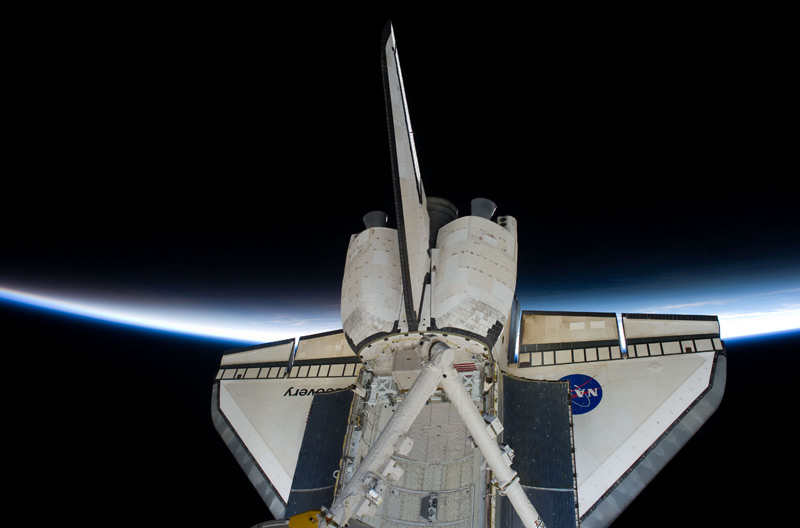Cloudy Skies, Rain Delay Shuttle Discovery's Return to Earth

Agloomy mix of low clouds and rain delayed the space shuttle Discovery'sreturn to Earth Monday, forcing its seven-astronaut crew to spend at least one moreday in orbit before coming home.
Thefoul weather at NASA's Kennedy Space Center in Florida thwarted two separateattempts to land Discovery on a runway at its home port. The next chance toland the shuttle will come on Tuesday at 7:33 a.m. EDT (1133 GMT).
Discovery'screw of seven astronauts thanked Mission Control for its efforts tosalvage a landing from today's gloomy weather.
"Weknow how much workload it is and we appreciate everything you've done,"shuttle commander Alan Poindexter told Mission Control. "We'll be hopefulfor better weather tomorrow."
Discoveryis returning to Earth after resupplying the International Space Station withtons of fresh supplies and new science equipment. With Monday's landing delay,the astronauts are now wrapping up a 15-day mission to stock up the orbitinglab.
NASAhoped to land the shuttle early Monday morning, but Mother Nature refused tocooperate. Shuttle flight rules forbid trying to land a space shuttle with rainshowers within 30 miles of its runway because the weather can damage thespacecraft's fragile heat shield tiles, among other risks.
Lowcloud ceilings, like the one that thwarted today's first landing attempt, arealso a problem because they affect runway visibility for shuttle commanders andpilots.
Breaking space news, the latest updates on rocket launches, skywatching events and more!
The cloud layer today was just 200 feet above the ground with visibility restricted to 2 miles, unacceptable for any shuttle landing attempts, NASA officials said.
On its first landing attempt Tuesday, Discovery will fly across the UnitedStates from the northwest to southeast when it re-enters Earth's atmosphere andmay be visible to observers on the ground. [Howto see Discovery's re-entry from Earth.]
Itis only the second time since the tragic loss of Columbia in 2003 that a NASAshuttle has flown over the United States during re-entry and approach tolanding (the last time was in 2007). NASA typically prefers to fly shuttles infrom the southwest to avoid flying through high-altitude noctilucent clouds andflying over populated areas.
MissionControl opted for the trajectory for Discovery's landing in order to give theshuttle astronauts extra time during their busy mission.
IfDiscovery is unable to return to Florida on Tuesday, NASA could opt to land theshuttle at a backup runway at the Edwards Air Force Base in California.
Theshuttle has multiple opportunities to land at both sites on Tuesday. But NASAprefers to land Discovery in Florida ? the shuttle fleet's home port and launchsite ? since it saves about a week of time and $1.8 million in transport coststo ferry the spacecraft home from California atop a modified Boeing 747 jumbojet.
Thevast ash cloud from Iceland'sEyjafjallaj?kull volcano poses no concern for Discovery's re-entry andlanding. Unlike air traffic in Europe, the shuttle's landing approach is wellclear of any regions affected by the volcanic ash plume.
Discoveryhas enough supplies to remain in space until Wednesday, but NASA wants to landthe shuttle by Tuesday in order to keep one day in reserve in case of anunexpected malfunction.
Discoverylaunched into space on April 5 on what has become a 14-day mission todeliver new science experiment equipment, supplies and big spare parts to theInternational Space Station. The astronauts performed three tough spacewalks toreplace an ammonia coolant tank outside the station.
Astuck valve inside the new tank has kept it from working properly, but MissionControl opted to have station astronauts fix it later on future spacewalk.
Thismission is one of NASA's last few shuttle flights before the space plane fleetis retired in September. It is the second-to-last mission for Discovery, whichis NASA's oldest space shuttle.
Afterthis flight, only three more shuttle missions remain. NASA's next space shuttleto fly is Atlantis, which will deliver a new Russian module to theInternational Space Station in May.
Atlantisis due to roll out to its seaside launch pad tonight.
- Images ? Shuttle Discovery's Mission in Pictures
- Morning Star: The Pre-dawn Launch of Shuttle Discovery
- Iceland Volcano's Ash Cloud No Threat to Space Shuttle Landing
SPACE.comis providing complete coverage of Discovery's STS-131 mission to theInternational Space Station with Managing Editor Tariq Malik and Staff WriterClara Moskowitz based in New York. Clickhere for shuttle mission updates and a link to NASA TV.
Join our Space Forums to keep talking space on the latest missions, night sky and more! And if you have a news tip, correction or comment, let us know at: community@space.com.

Tariq is the award-winning Editor-in-Chief of Space.com and joined the team in 2001. He covers human spaceflight, as well as skywatching and entertainment. He became Space.com's Editor-in-Chief in 2019. Before joining Space.com, Tariq was a staff reporter for The Los Angeles Times covering education and city beats in La Habra, Fullerton and Huntington Beach. He's a recipient of the 2022 Harry Kolcum Award for excellence in space reporting and the 2025 Space Pioneer Award from the National Space Society. He is an Eagle Scout and Space Camp alum with journalism degrees from the USC and NYU. You can find Tariq at Space.com and as the co-host to the This Week In Space podcast on the TWiT network. To see his latest project, you can follow Tariq on Twitter @tariqjmalik.
